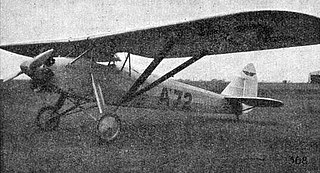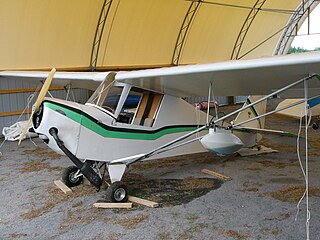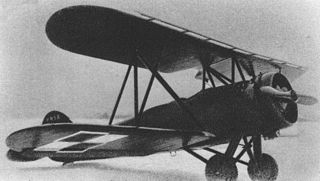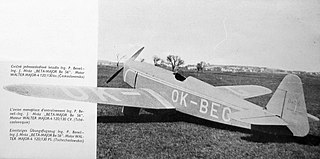Related Research Articles
The Aeronca Model 9 Arrow was a low-wing all-metal cabin monoplane with retractable landing gear. It was marketed to returning pilots from World War II and unveiled in 1947 but never went into production.

The Albatros B.I, was a German military reconnaissance aircraft designed in 1913 and which saw service during World War I.

The All American 10A Ensign was a two-seat light plane built in the United States shortly after World War II. It was a low-wing, all-metal cantilever monoplane with fixed tricycle undercarriage and which seated its pilot and passenger side by side under an expansive bubble canopy. Due to the glut of military surplus aircraft on the civil market after the war, All American was unable to attract buyers and no production ensued.

The Darmstadt D-22 was a sports-plane of Germany, designed and built by Akaflieg of Technische Universität Darmstadt.
The Civil Aviation Department Revathi was a light utility aircraft designed in India principally for use by that country's flying clubs.
The Gatard Statoplan AG 02 Poussin was a light, single-seat sports airplane developed in France in the late 1950s and marketed for homebuilding. In layout, it was a low-wing cantilever monoplane of short-coupled design with fixed tailwheel undercarriage. Construction was a plywood-covered wooden structure throughout, and the cockpit was enclosed by a large perspex bubble canopy. The variable-incidence horizontal stabiliser was fitted with small endplates to provide extra directional stability but there were no separate elevators.
The Gatard Statoplan AG 04 Pigeon was a light utility aircraft developed in France in the 1970s. It was a high-wing strut-braced monoplane with fixed tailwheel undercarriage. The wings could be quickly folded to facilitate storage or towing. As with Gatard's previous Poussin, the Pigeon was built around an unconventional flight control system that relied on varying its wings' camber to provide most of its climb, rather than their angle of attack. A prototype, registered F-WYBB flew in 1976, and although it was intended to market the design to homebuilders, this did not transpire.

The Hopfner HS-8/29 was a utility aircraft built in Austria in the late 1920s based on the Hopfner HS-5/28. It used a modernised version of its predecessor's airframe, being a conventional, parasol-wing monoplane with seating for two occupants in tandem, open cockpits. The landing gear was of fixed, tailskid type with divided main units. The first prototype used the same Walter NZ 85 engine that the later HS-5/28s had used, but this was followed by 14 production examples with Siemens engines, and a single prototype with a de Havilland Gipsy III.

The Koolhoven F.K.48 was an airliner built in the Netherlands in 1934 for KLM.

The Fisher FP-101 is an American single-seat, high-wing, conventional landing gear, tractor configuration single engine ultralight aircraft that was available in kit form from Lite Flite of South Webster, Ohio and later Fisher Flying Products of Edgeley, North Dakota.

The PWS-5 or PWS-5t2, was a multi-seated Polish liaison aircraft, developed in 1928 by PWS.

The PWS-6, was a Polish liaison aircraft, developed in 1930 by the PWS, that remained a prototype.

The PWS-4 was a prototype Polish sports aircraft, developed in 1928 by Podlaska Wytwórnia Samolotów.
The Harmon Der Donnerschlag is an American homebuilt aircraft that was designed and produced by Harmon Engineering of Howe, Texas. The aircraft was intended for amateur construction.
The AeroLites AeroMaster AG is an American homebuilt agricultural aircraft, designed and produced by AeroLites of Welsh, Louisiana. The aircraft is supplied as a kit for amateur construction.
The Adventure Wheely II is a French powered parachute that was designed and produced by Adventure SA of Paris. Now out of production, when it was available the aircraft was supplied as a complete ready-to-fly-aircraft.
The Caproni Ca.146 was a high-wing reconnaissance aircraft built by Caproni in the mid-1930s.

The Beneš-Mráz Be-56 Beta-Major was a single-seat aerobatic advanced trainer manufactured in Czechoslovakia shortly before World War II.
The Scheibe SF 32 is a German motorglider that was designed by Egon Scheibe in the 1970s.
The Breda A.1 was a touring aircraft developed in Italy in 1924.
References
- ↑ "Gatard AG-01 'Statoplan Alouette' - avion de tourisme - Un siècle d'aviation française". Aviafrance.com. 2005-12-13. Retrieved 2019-02-03.CS1 maint: discouraged parameter (link)